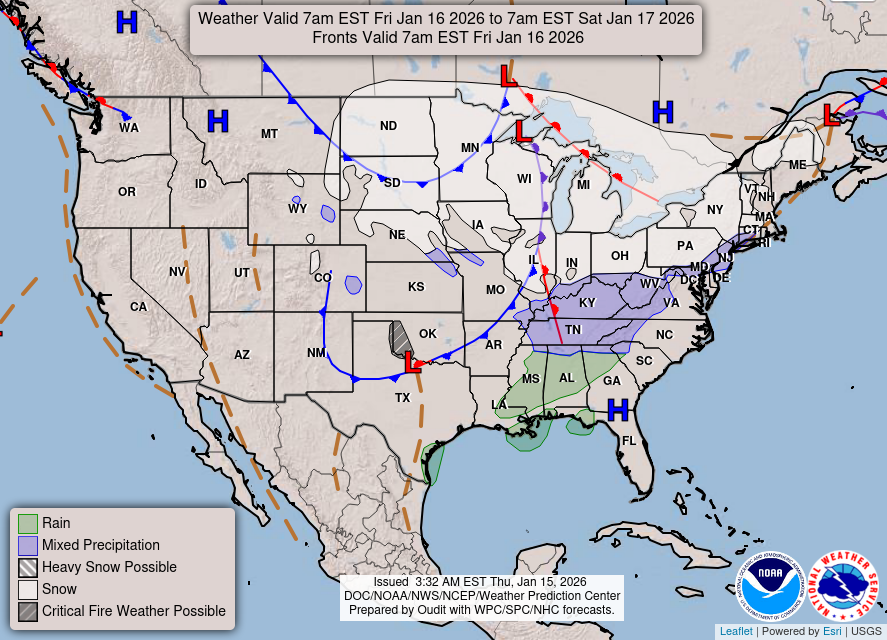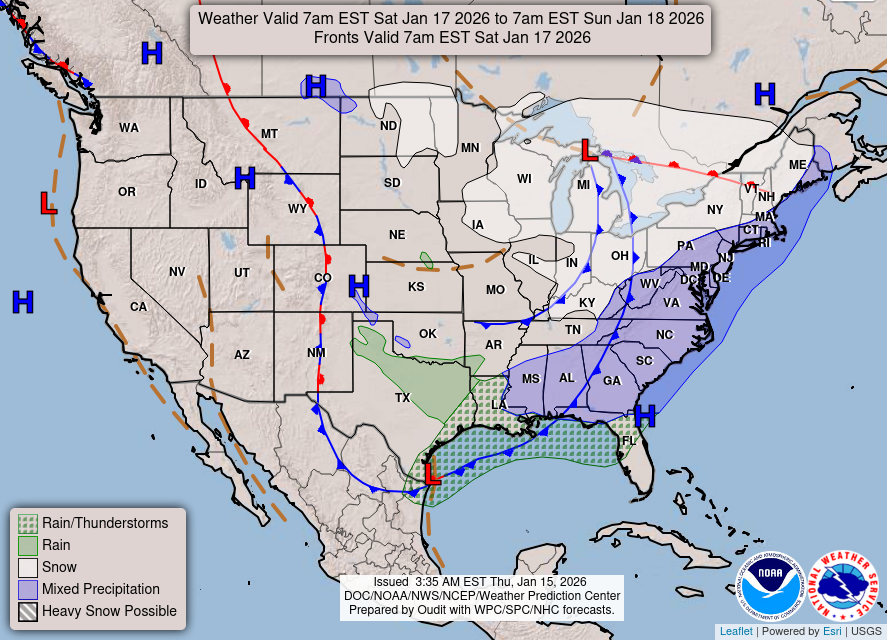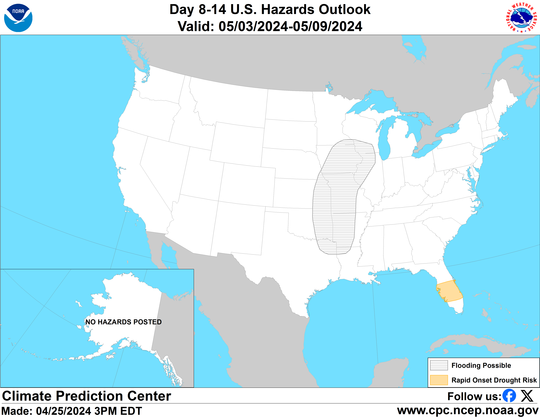This article focuses on what we are paying attention to in the next 48 to 72 hours. The article also includes weather maps for longer-term U.S. outlooks (up to four weeks) and a six-day World weather outlook which can be very useful for travelers.
First the NWS Short Range Forecast. The afternoon NWS text update can be found here after about 4 p.m. New York time but it is unlikely to have changed very much from the morning update. The images in this article automatically update.
Short Range Forecast Discussion
NWS Weather Prediction Center College Park MD
Mon Nov 18 2024
Valid 12Z Mon Nov 18 2024 – 12Z Wed Nov 20 2024…A potent storm system over the central U.S. today will create chances
for heavy rainfall, severe thunderstorms, and gusty winds, while moderate
snowfall is possible across the northern Plains by Tuesday……Heavy rain and flash flooding potential exists throughout the central
and eastern Gulf Coast over the next few days……Powerful Pacific low pressure system to impact the Northwest with high
winds and heavy mountain snow, while an atmospheric river takes aim at
northern California by Wednesday…An amplified weather pattern and two separate strong storm systems are set
to impact the Nation during the first half of this week. First, a deep low
pressure system ejecting out of West Texas early this morning is
anticipated to further organize over the central U.S. today and produce
areas of heavy rain, severe weather, and gusty winds to the
southern/central Plains. Thunderstorms forming along an attached cold
front may contain damaging winds and perhaps a few tornadoes between
central Oklahoma and North Texas today. This region is where the Storm
Prediction Center has hoisted a Slight Risk (level 2/5) of severe
thunderstorms. As the system progresses northward into the Upper Midwest
on Tuesday, showers are also forecast to spread north throughout parts of
the Midwest and Great Lakes. Meanwhile, cold air working into the western
side of the storm will likely allow for precipitation to fall as snow
across parts of North Dakota and northern Minnesota into Wednesday.
Snowfall may also be accompanied by gusty winds, leading to lower
visibility on roadways. Current snowfall probabilities for at least 4
inches of snow are greatest (70-90%) across north-central North Dakota.As the associated cold front pushes eastward through Tuesday, numerous
showers and thunderstorms interacting with a surge of moisture being
lifted northward from the Gulf of Mexico could contain intense rainfall
rates capable of producing flash flooding. Heavy rainfall is most likely
tonight across eastern Louisiana and southern Mississippi, with the threat
expanding east to the Florida Panhandle on Tuesday. Scattered flash floods
are most likely throughout low-lying and urban regions. Residents and
visitors are reminded to have multiple ways to receive warnings and never
drive across flooded roadways.For much of the Northwest, northern Great Basin, and northern Rockies, a
cold front pushing across the region today and enhanced onshore flow will
allow for unsettled weather to continue ahead of a powerful storm system
forecast to develop off the coast of the Northwest on Tuesday. This
appetizer of precipitation to start the workweek will mainly include the
potential for moderate to heavy snowfall across the Cascades and northern
Rockies. However, by Tuesday night the rapidly strengthening Pacific low
pressure system will aid in producing high winds across the Pacific
Northwest and increasing precipitation intensity. Wind gusts up to 70 mph
are possible across parts of northern California and Oregon, with strong
winds also expected over parts of western Washington. These winds will
have the potential to knock down trees and produce power outages. Heavy
snowfall with amounts potentially exceeding two feet are possible over the
northern California ranges and Cascades. By Wednesday, an associated
atmospheric rive event is expected to take shape and direct continuous
Pacific moisture towards northern California and southwest Oregon.
Widespread rainfall amounts of 4 to 7 inches are expected through
Wednesday across this region, which could produce areas of river flooding
and increase the risk of mudslides. Heavy rain and the associated weather
hazards from this atmospheric river event are also expected to continue
beyond midweek.Below average temperatures are forecast to remain over much of the western
U.S. over the next few days while gradually spreading eastward into the
Great Plains. Meanwhile, high pressure over the East will continue to
create mild and dry conditions through Tuesday as rainfall chances enter
the Mid-Atlantic and Northeast on Wednesday.
To get your local forecast plus active alerts and warnings click HERE and enter your city, state or zip code.
Learn about wave patterns HERE.
Then, looking at the world and of course, the U.S. shows here also. Today we are looking at precipitation.
Please click on “Read More” below to access the full Daily Report issued today.
| Notices: What would you like to learn about? Please provide that to me via the comment section at the end of the article. |
Now more detail on the 48-Hour Forecast (It is a 48 to 72 Hour Forecast actually)
Daily weather maps. The Day 1 map updates twice a day and the Day 2 and 3 maps update only once a day. These maps update automatically. But if that does not happen, you can get updates by clicking HERE
TODAY (or late in the day the evening/overnight map will appear) (Key to surface fronts shown on maps and you will then also be able to insert a city name or zip code and get a local NWS forecast).

TOMORROW

NEXT DAY

We have a new animation of the forecast which shows how things may play out over the next 60 hours. To update click ANIMATION. Doing so will get you to the dashboard. You can then step through the animation or hit LOOP on the upper right of the display. You will have to hit the back arrow ← at the top left on your computer to get back into this article. It is a little more trouble than before but I think NOAA scrapped the animation routine I was using so we have to keep up with “progress”.
The NWS Climate Prediction Center’s: Watches, Warnings, and Advisories plus other information can be found HERE. That takes you to the NWC Severe Weather Site. From there you can select among many categories of information. Remember to hit the back arrow ← at the top left of your screen to return to this article.
ATMOSPHERIC RIVERS
This tells us what is approaching the West Coast. Click HERE to update If I have not gotten around to doing the update. Here is some useful information about Atmospheric Rivers.

Below is the current five-day cumulative forecast of precipitation (Updates can be found HERE)

Ski SnowReports will Resume in the Fall.
Now we look at Intermediate-Term “Outlook” maps for three time periods. Days 6 – 10, Days 8 – 14, and Weeks 3 and 4. An outlook differs from a forecast based on how NOAA uses these terms in that an “outlook” presents information as deviation from normal and the likelihood of these deviations.
Below are the links to obtain updates and additional information. They are particularly useful if you happen to be reading this article significantly later than when it was published. I always try to provide readers with the source of the information in my articles. These links may also be useful for those viewing this article on a cell phone or other small screen.
| Days 6 – 10 (shown in Row 1) | Days 8 – 14 (Shown in Row 2) | Weeks 3 and 4 (Shown in Row 3 but updates only on Fridays) |
| https://www.cpc.ncep.noaa. gov/products/predictions/610day/ | https://www.cpc.ncep .noaa.gov/products/predictions/814day/ | https://www.cpc.ncep.noaa.gov/products/predictions/WK34/ |
Showing the actual maps. They should now update automatically. The Week 3 – 4 Outlook only updates on Fridays. So below is what I call the Intermediate-term outlook. On Fridays, it extends out 28 Days. That declines day by day so on Thursday it only looks out 22 days until the next day when the Week 3 – 4 Outlook is updated and this extends the outlook by one additional week.
| 6–
10
|
|
|
| 8–
14 |
|
|
| 3–
4 |
|
|
HAZARDS OUTLOOKS
Click here for the latest complete Day 3 -7 Hazards forecast which updates only on weekdays. Once a week probably Monday or Tuesday I will update the images. I provided the link for readers to get daily updates on weekdays. Use your own judgment to decide if you need to update these images. I update almost all the images Friday Night for the weekend edition of this Weather Report. So normally readers do not need to update these images but if the weather is changing quickly you may want to.

Temperature month to date can be found at https://hprcc.unl.edu/products/maps/acis/MonthTDeptUS.png
Precipitation month to date can be found at https://hprcc.unl.edu/products/maps/acis /MonthPNormUS.png
World Forecast [that website is has been intermittent so be patient]
Below are the Day 1 -3 and 4-6 forecasts for temperature and precipitation. Updates and much additional information can be obtained HERE
World Temperature Anomalies


World Accumulated Precipitation


This information is provided by the University of Maine. They draw upon many different sources. There is a lot of information available at the link provided. I have just provided two useful forecasts. There are probably over a hundred different forecasts available from this source.
Worldwide Tropical Forecast (This is a NOAA Product)
This graphic updates on Tuesdays) If it has not been updated, you can get the update by clicking here Readers will only have to do that if they are reading this article much later than the date of it being published.
Information on Tropical Storms can be found HERE. Western Pacific information can be found HERE. Note that unless there is an out-of-season storm the below images will not update until the National Hurricane Center starts their seasonal update of these maps on June 1. I include them simply because there can be an out-of-season event in which case it should show up in these maps.


–
| I hope you found this article interesting and useful. |








